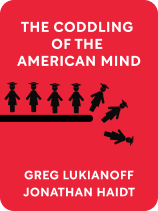

This article is an excerpt from the Shortform book guide to "The Coddling of the American Mind" by Greg Lukianoff and Jonathan Haidt. Shortform has the world's best summaries and analyses of books you should be reading.
Like this article? Sign up for a free trial here .
What are the 3 untruths in The Coddling of the American Mind? What two big impacts do these untruths have in colleges?
In the book The Coddling of the American Mind, there are 3 untruths among college students today: the untruth of fragility, the untruth of emotional reasoning, and the untruth of us versus them. The book’s authors claim that these 3 untruths have two very serious consequences for college students.
Keep reading for details about the 3 untruths in The Coddling of the American Mind.
The Three Great Untruths
In The Coddling of the American Mind, Greg Lukianoff and Jonathan Haidt argue that 3 “Great Untruths,” have gained a strong foothold among young people, especially those on college campuses.
- You must strive to avoid bad experiences at all costs.
- You must always trust your emotions over reason.
- The world is a black-and-white battle between good people and bad people; there is no middle ground.
These beliefs insulate students from ideas with which they disagree, are deeply dangerous to free expression and are harmful to students’ emotional development. By succumbing to their own sense of fragility and wrapping themselves in the cloak of victimhood, young people today are developing cognitive patterns similar to those of people suffering from anxiety and depression.
Ultimately, young people must develop the skills and fortitude to feel empowered. Being exposed to controversial ideas and unpleasant experiences is a vital part of human development. The key is not to crumple and retreat into learned helplessness in the face of adversity; but rather, to overcome it and emerge better and stronger.
Here are The Coddling of the American Mind‘s 3 untruths:
Untruth #1: The Untruth of Fragility
The first untruth is that exposure to adversity or discomfort is inherently damaging. This is a falsehood—stressors and risks are necessary parts of human emotional development. And young people are no exception.
Safetyism and the Alleged Danger of Speech
The people and institutions that are most responsible for young people’s healthy development—parents, teachers, schools, universities—have actively shielded them from any form of adversity.
This is the ideology of safetyism—the idea that one’s freedom from emotional discomfort trumps all other moral concerns and trade-offs. In this formulation, “safety” increasingly means being sheltered from opinions that one doesn’t agree with.
The Social-Media Natives of Generation iGen
It is unsurprising that this idea of safety is prevalent among the members of Generation iGen, who can best be described as social-media natives. In the online worlds of Facebook, Twitter, and Instagram, one truly can curate a world populated only by those who share one’s cultural, aesthetic, and political preferences. Unfortunately, they expect to be able to replicate this in the real world.
Defining Trauma Down
This language of safety and trauma is now applied to experiences and topics where it never would have been before. Increasingly, students conflate trauma with emotional discomfort. But emotional discomfort is simply not the same as trauma. At many colleges, students claim that mere exposure to certain classroom materials is traumatic and threatens their emotional and psychological well-being.
This is inherently poisonous to the atmosphere of free discussion of ideas, which is supposed to be a hallmark of academia.
Untruth #2: The Untruth of Emotional Reasoning
The second untruth is that you must always trust your emotions.
Too often, emotional reasoning causes us to misperceive the world around us. For young people, emotional reasoning can cause them to feel intentional slights where there are none and strengthen the desire to shelter themselves from emotionally triggering experiences—even speech that they merely disagree with.
Negative-Feedback Loops
Emotional reasoning can have negative consequences. It often leads to negative cognitive feedback loops. Individuals who suffer from anxiety and depression often start from a place of low self-esteem. And because they feel so badly about themselves, they selectively seek out “proof” to confirm their negative self-beliefs. These “proofs,” in turn, further reinforce the original negative beliefs.
The Threat to Critical Thinking
Alarmingly, these patterns of negative thought are strikingly similar to the ways in which overprotected university students interpret speech or ideas with which they disagree. Not only is this disruptive in a classroom setting, but it also inhibits the development of critical thinking—the skill that enables people to absorb new information and revise incorrect beliefs.
Microaggression and Misperception
Another dangerous manifestation of emotional reasoning can be seen in the phenomenon of so-called “microaggressions.” Microaggressions are minor, often inadvertent slights that members of minority groups are often exposed to in the course of daily life. An excessive focus on these incidents can cause the recipient to misperceive intentional slight where there was none.
De-Platforming
One more product of faulty emotional reasoning is the phenomenon of de-platforming. De-platforming occurs when controversial guest lecturers, speakers, or debaters who are invited to a university campus to discuss issues are unable to speak due to protests by student activist groups.
Untruth #3: The Untruth of Us Versus Them
The third untruth is that the world is defined by a black-and-white struggle between the forces of good and evil. Psychological research shows that the human mind is hardwired to sympathize with members of our in-group and fear and distrust members of an out-group.
Common-Enemy Identity Politics
Identity politics is a form of political mobilization based on some shared group characteristic, often race, ethnicity, nationality, gender expression, or sexual orientation.
Common-enemy identity politics uses the alleged threat of a shared adversary to mobilize its supporters. Usually, the enemy is cast as an oppressor and the mobilized group casts itself as a marginalized population struggling to remove its shackles.
This contrasts with common-humanity identity politics, as practiced by the Reverend Dr. Martin Luther King, Jr., which grounds its appeal in a universalist message of justice and decency.
Call-Out Culture
Call-out culture is the public shaming of “oppressors” on campus, often for the most trivial offenses. Social media makes call-out culture much more pervasive and cruel, as it gives the online attackers a sense of anonymity that allows them to relax their moral inhibitions.
Call-out culture has a chilling effect on free speech on campus, as students, faculty, and administrators are forced to resort to self-censorship out of fear of being socially vilified for politically incorrect opinions.
Bad Impact #1: The Suppression of Speech
These untruths have major consequences. Their first negative impact is that they have convinced students that violence and intimidation are acceptable—even necessary—responses to speech that they dislike.
One disturbing idea is that certain forms of speech ought to be considered a form of violence. The logic of this argument is that inflammatory speech can cause emotional distress. Emotional distress, in turn, can have harmful effects on one’s physical health. Therefore, since some forms of speech can lead to physical harm, such speech ought to be considered the moral equivalent of physical violence.
By this logic, of course, almost anything could be considered an act of violence, since anything is likely to be emotionally stressful to at least someone. This becomes an open invitation for a listener to respond to nearly any speech with which she disagrees with actual violence.
In March 2017, an outbreak of violence occurred at Middlebury College in Vermont. There, controversial right-wing author Charles Murray was scheduled to speak. Murray, in his 1994 book The Bell Curve, argued that social and economic inequality is the result of innate genetic differences that render blacks, Latinos, women, and the poor intellectually inferior to white men. Students at Middlebury responded by rioting, destroying property, and even physically threatening Murray and members of the faculty.
Bad Impact #2: Orthodoxy and Groupthink on Campus
The second negative impact of these ideas is that they have led to ideological orthodoxy and groupthink on college campuses—and the persecution of those who are perceived to be dissenters.
As opinion within academic circles has grown more uniformly left-wing, it has become less tolerant of diverging viewpoints. Scholars increasingly evaluate one another’s work not on its merits, but on the basis of whether or not it deviates from shared left-wing orthodoxy.
Recent years have seen a disturbing willingness within academic journals and publications to censor views that contradict left-wing orthodoxy, particularly when it comes to matters of race and class. One professor who merely questioned the fairness of a “Day of Absence” (during which white students were asked by activists not to come to campus for a day) was vilified, harassed, and attacked by students and even fellow faculty—and eventually forced to leave the campus.

———End of Preview———
Like what you just read? Read the rest of the world's best book summary and analysis of Greg Lukianoff and Jonathan Haidt's "The Coddling of the American Mind" at Shortform .
Here's what you'll find in our full The Coddling of the American Mind summary :
- The "three Untruths" that have taken hold of young people
- The damage that "speech codes" cause on college campuses
- How colleges are increasingly seeing students as customers






